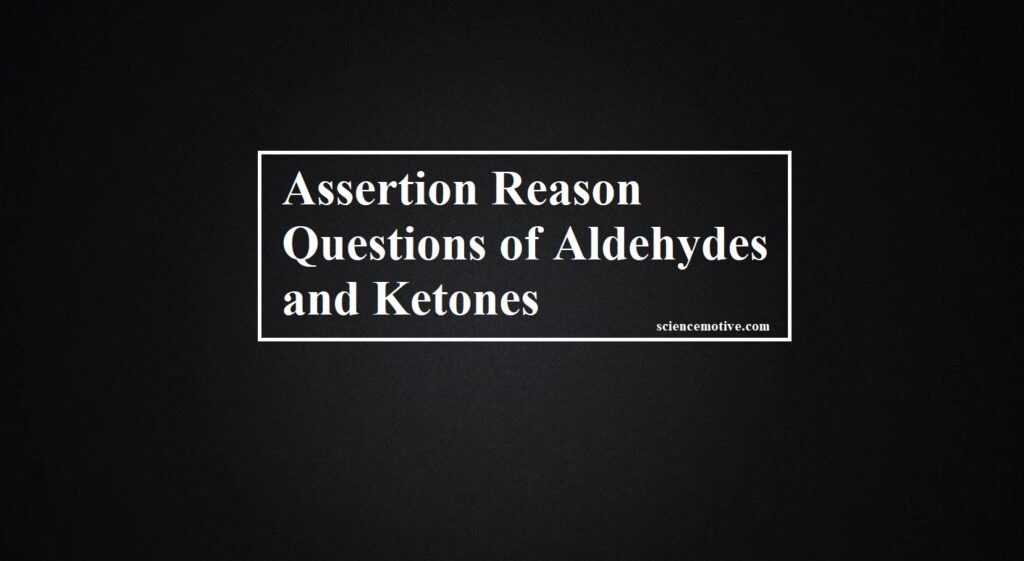Assertion Reason Questions of Aldehydes and Ketones
Assertion Reason Questions of Aldehydes and Ketones
Read the assertion and reason carefully to mark the correct option out of the options given below:
(a) If both assertion and reason are true and the reason is the correct explanation of the assertion.
(b) If both assertion and reason are true but the reason is not the correct explanation of the assertion.
(c) If the assertion is true but the reason is false.
(d) If the assertion is false but the reason is true.
(e) If the assertion and reason both are false
Que 1. Assertion: Acetic acid does not undergo a haloform reaction.
Reason: Acetic acid has no alpha hydrogens.
Ans 1. c
Que 2. Assertion: Carboxylic acids do not show the properties of a carbonyl group.
Reason: The -C=O in the carboxyl group is in resonance with the -OH group.
Ans 2. a
Que 3. Assertion: Benzonitrile is prepared by the reaction of chlorobenzene with potassium cyanide.
Reason: Cyanide (CN–) is a strong nucleophile.
Ans 3. e
Que 4. Assertion: Chloroacetic acid has a higher pKa value than Acetic acid.
Reason: The – I effect of Cl further stabilizes the carboxylate anion formed by the loss of the proton.
Ans 4. d
Que 5. Assertion: Lower aldehyde and ketones are soluble in water but the solubility decreases as molecular mass increases.
Reason: Aldehydes and ketones can be distinguished by Tollen’s reagent.
Ans 5. b
Assertion Reason Questions of Aldehydes and Ketones
Que 6. Assertion: Acetaldehyde on treatment with alkaline gives aldol.
Reason: Acetaldehyde molecules contain a hydrogen atom.
Ans 6. a
Que 7. Assertion: Benzaldehyde resists nucleophilic addition in comparison with Ethanal
Reason: The Phenyl group in benzaldehyde is too bulky and therefore prevents the attack of Nucleophile.
Ans 7. c
Que 8. Assertion: Acetylene on treatment with alkaline KMnO4 produce acetaldehyde.
Reason: Alkaline KMnO4 is a reducing agent.
Ans 8. e
Que 9. Assertion: Aldehydes undergo aldol condensation only if it has α-hydrogen.
Reason: The ∝-hydrogen in aldehydes are acidic in nature because the anion formed by the loss of the ∝-hydrogen is resonance stabilized.
Ans 9. a
Que 10. Assertion: Acetophenone and benzophenone can be distinguished by the iodoform test.
Reason: Acetophenone and benzophenone both are carbonyl compounds.
Ans 10. b
Assertion Reason Questions of Aldehydes and Ketones
Que 11. Assertion: Isobutanal does not give an iodoform test.
Reason: It does not have ∝-hydrogen.
Ans 11. c
Que 12. Assertion: Benzaldehyde is more reactive than ethanol towards nucleophilic attack.
Reason: The overall effect of –I and +R effect of phenyl group decrease the electron density on the carbon atom of > C = O group in benzaldehyde.
Ans 12. a
Que 13. Assertion: Ketones have a low boiling point compared to corresponding alcohols.
Reason: Ketones from intermolecular hydrogen bonding with alcohols.
Ans 13. b
Que 14. Assertion: Aldol condensation can be catalyzed both by acids and bases.
Reason: b-Hydroxy aldehydes or ketones readily undergo acid-catalyzed dehydration.
Ans 14. b
Que 15. Assertion: Carboxylic acids have a greater boiling point than alcohol.
Reason: Carboxylic acids have the ability to form dimers in solution.
Ans 15. b
Que 16. Assertion: Ketones are less reactive than aldehydes.
Reason: Ketones do not give Schiff’s test.
Ans 16. b
Que 17. Assertion: Dry HCl is a must for the reaction of an aldehyde with alcohol to form hemiacetal.
Reason: HCl protonates the carbonyl oxygen increasing the electrophilicity of the carbonyl carbon.
Ans 17. a
Que 18. Assertion: Oximes are less acidic than hydroxylamine.
Reason: Oximes of aldehydes and ketones show geometrical isomerism.
Ans 18. d
Que 19. Assertion: Even though there are two NH2 groups in semicarbazide, only one reacts with carbonyl compounds
Reason: Semicarbazide has two NH2 groups out of which one is in resonance with the carbonyl group.
Ans 19. a
Que 20. Assertion: The bond energy of > C = O is less than > C = C < in alkenes.
Reason: The carbon atom in the carbonyl group is sp2 hybridized.
Ans 20. d
Assertion Reason Questions of Aldehydes and Ketones
Que 21. Assertion: Benzoic acid does not undergo Freidel Crafts reaction.
Reason: The carboxyl group in benzoic acid donates electrons into the ring through resonance.
Ans 21. c
Que 22. Assertion: Formaldehyde cannot be prepared by Rosenmund’s reduction.
Reason: Acid chlorides can be reduced into aldehydes with hydrogen in boiling xylene using palladium or platinum as a catalyst supported on barium sulphate. This is known as Rosenmund’s reduction.
Ans 22. b
Que 23. Assertion: Ketones are more reactive than aldehydes towards nucleophilic addition.
Reason: The alkyl groups in ketone increase the electron density on the carbonyl carbon through the +I effect.
Ans 23. D
Que 24. Assertion: a-Hydrogen atoms in aldehydes and ketones are acidic.
Reason: The anion left after the removal of a-hydrogen is stabilized by the inductive effect.
Ans 24. c
Que 25. Assertion: 2, 2–Dimethyl propanal undergoes Cannizzaro reaction with concentrated NaOH.
Reason: Cannizzaro is a disproportionation reaction.
Ans 25. b
Assertion Reason Questions of Aldehydes and Ketones
CLASS 12 CHEMISTRY IMPORTANT QUESTIONS – TERM 1



